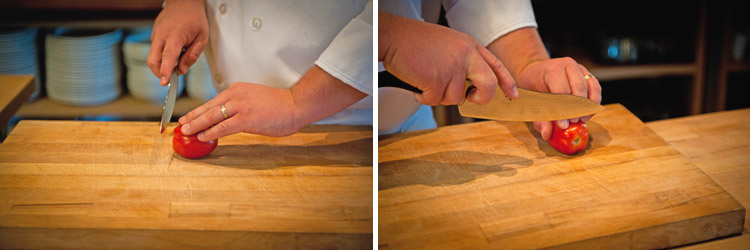Learning how to properly use your guide hand will not only improve the overall accuracy of your knife skills, but it will also keep you from slicing off your thumb, (a small added bonus).
Shown below are two things you DON’T want to do when using your guide hand. The first photo (on the left), shows a guide hand with fingers that are way too flat. This grip will not only lead you to slicing the tips of your fingers, but it also doesn’t “guide” your knife at all, defeating the whole purpose of having a guide hand. In the second photo, you can see that my thumb is protruding forward, very much in the way of my knife blade. In fact, one of the most common injuries many amateurs will experience is slicing their thumb due to improper guide hand technique.

The picture below is demonstrating the proper use of the guide hand technique while slicing a roma tomato. The fingertips are slightly curled, with the side of the knife resting against the first knuckle on the middle finger. Keeping this constant contact with the first knuckle, and having your finger tips curled slightly behind your knuckles, will insure you always know where the blade of you knife is and be in control of it’s direction at all times.
This will not only lead to more accurate cuts, but it will speed up your knife skills considerably. With proper guide hand technique, you should be able to make slices with your eyes closed or while looking away. This is because you’re relying on the constant contact between your guide hand and knife blade to control where your blade is going.

Notice how the thumb is tucked behind the fingers on the backside of the tomato. Again, a lot of cuts occur because people leave their thumb hanging out to the side. When using your guide hand technique properly, your thumb will always be safely tucked behind your fingers.

